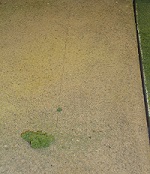Protecting a Foam Module Top from Compression Damage
by Steve Gillett
The use of extruded foam on top of modules is now very popular. Many N-Trak modules have a sheet of ½” or ¾” foam
glued to the ½” plywood module top allowing for landscape contours below the track grade. Extruded foam is fairly
rigid and, if accidental compressed, it will not rebound to its previous shape. Accidental compression of the foam
is generally not a problem, since true ground areas are rarely flat anyway.
However, foam compression can become a problem when it occurs under the area where the rail joiner tracks are installed.
Without firm, flat support underneath them, the joiner tracks can sag as trains pass over them, thereby causing
uncoupling, derailment or other problems. Some module builders place a 2’ long piece of 1” x 4” hardwood flat along
each end of the module to protect an area 3½” in from each side and which fits flush with the ¾” thick foam that
covers the rest of the module. Unfortunately, wood and extruded foam have different coefficients of expansion and
therefore, over time, cracks appear in the module’s ground cover along the seam between wood and foam. (Figure 1)
You can solve this cracking problem and provide adequate support beneath the joiner track area by still using a
piece of 1” x 4” hardwood, but making it only 4” long and rotating it 90°. Cover the entire module top with foam,
then center the 4” long piece of wood under the yellow (middle) line at each end of the module. (Figure 2) Since
dimensional lumber 1” x 4”s are actually ¾” thick and 3½” wide, this placement will make the piece of wood extend
forward and back 1¾” from the center of the yellow line, which is sufficient to underlie both the red (front) line
and the blue (rear) line. (Figure 3) With a sharp knife, cut the foam along the edges of the lumber, remove the cut
block of foam, (Figure 4) and glue and screw the piece of wood in its place. (Figure 5 & 6) Obviously, if your foam is
of a different thickness than ¾” you will need to use an equivalently thick piece of wood. (Figure 7)
The red and blue line’s cork roadbed will overlap the seam between the wood and the foam and will hide any cracks that occur due to expansion and contraction. (Figure 8 & 9) You can then proceed with track ballasting as normal. (Figure 10 & 11) When it’s time to install joiner tracks, you will have a firm piece of hard wood where you are pressing down with you joiner tool and will not have to worry about damaging the foam.










